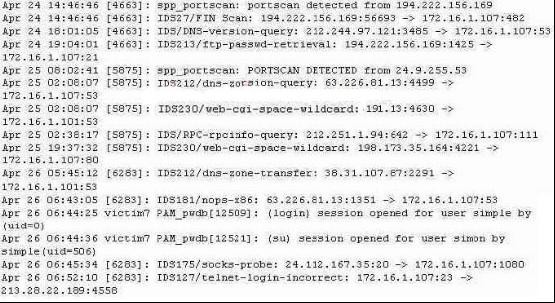- (Topic 23)
If an attacker's computer sends an IPID of 24333 to a zombie (Idle Scanning) computer on a closed port, what will be the response?
Correct Answer:
C
- (Topic 19)
The following excerpt is taken from a honeypot log. The log captures activities across three days. There are several intrusion attempts; however, a few are successful. From the options given below choose the one best interprets the following entry:
Apr 26 06:43:05 [6282] IDS181/nops-x86: 63.226.81.13:1351 -> 172.16.1.107:53
(Note: The objective of this question is to test whether the student can read basic information from log entries and interpret the nature of attack.)
Interpret the following entry:
Apr 26 06:43:05 [6283]: IDS181/nops-x86: 63.226.81.13:1351 -> 172.16.1.107.53
Correct Answer:
B
The IDS log file is depicting numerous attacks, however, most of them are from different attackers, in reference to the attack in question, he is trying to mask his activity by trying to act legitimate, during his session on the honeypot, he changes users two times by using the "su" command, but never triess to attempt anything to severe.
- (Topic 23)
Charlie is the network administrator for his company. Charlie just received a new Cisco router and wants to test its capabilities out and to see if it might be susceptible to a DoS attack resulting in its locking up. The IP address of the Cisco switch is 172.16.0.45. What command can Charlie use to attempt this task?
Correct Answer:
A
- (Topic 3)
You ping a target IP to check if the host is up. You do not get a response. You suspect ICMP is blocked at the firewall. Next you use hping2 tool to ping the target host and you get a response. Why does the host respond to hping2 and not ping packet?
[ceh]# ping 10.2.3.4
PING 10.2.3.4 (10.2.3.4) from 10.2.3.80 : 56(84) bytes of data.
--- 10.2.3.4 ping statistics ---
3 packets transmitted, 0 packets received, 100% packet loss
[ceh]# ./hping2 -c 4 -n -i 2 10.2.3.4
HPING 10.2.3.4 (eth0 10.2.3.4): NO FLAGS are set, 40 headers + 0 data bytes
len=46 ip=10.2.3.4 flags=RA seq=0 ttl=128 id=54167 win=0 rtt=0.8 ms len=46 ip=10.2.3.4 flags=RA seq=1 ttl=128 id=54935 win=0 rtt=0.7 ms len=46 ip=10.2.3.4 flags=RA seq=2 ttl=128 id=55447 win=0 rtt=0.7 ms len=46 ip=10.2.3.4 flags=RA seq=3 ttl=128 id=55959 win=0 rtt=0.7 ms
--- 10.2.3.4 hping statistic ---
4 packets tramitted, 4 packets received, 0% packet loss round-trip min/avg/max = 0.7/0.8/0.8 ms
Correct Answer:
C
Default protocol is TCP, by default hping2 will send tcp headers to target host's port 0 with a winsize of 64 without any tcp flag on. Often this is the best way to do an 'hide ping', useful when target is behind a firewall that drop ICMP. Moreover a tcp null-flag to port 0 has a good probability of not being logged.
- (Topic 23)
An attacker finds a web page for a target organization that supplies contact information for the company. Using available details to make the message seem authentic, the attacker drafts e-mail to an employee on the contact page that appears to come from an individual who might reasonably request confidential information, such as a network administrator.
The email asks the employee to log into a bogus page that requests the employee's user name and password or click on a link that will download spyware or other malicious programming.
Google's Gmail was hacked using this technique and attackers stole source code and sensitive data from Google servers. This is highly sophisticated attack using zero-day exploit vectors, social engineering and malware websites that focused on targeted individuals working for the company.
What is this deadly attack called?
Correct Answer:
A